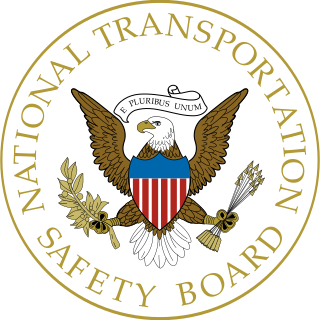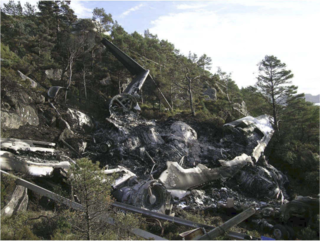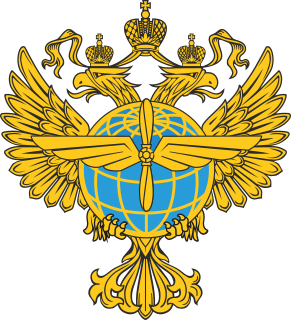
The National Transportation Safety Board (NTSB) is an independent U.S. government investigative agency responsible for civil transportation accident investigation. In this role, the NTSB investigates and reports on aviation accidents and incidents, certain types of highway crashes, ship and marine accidents, pipeline incidents, bridge failures, and railroad accidents. The NTSB is also in charge of investigating cases of hazardous materials releases that occur during transportation. The agency is based in Washington, D.C. It has four regional offices, located in Anchorage, Alaska; Denver, Colorado; Ashburn, Virginia; and Seattle, Washington. The agency also operates a national training center at its Ashburn facility.

An aviation accident is defined by the Convention on International Civil Aviation Annex 13 as an occurrence associated with the operation of an aircraft, which takes place from the time any person boards the aircraft with the intention of flight until all such persons have disembarked, and in which a) a person is fatally or seriously injured, b) the aircraft sustains significant damage or structural failure, or c) the aircraft goes missing or becomes completely inaccessible. Annex 13 defines an aviation incident as an occurrence, other than an accident, associated with the operation of an aircraft that affects or could affect the safety of operation.

Transport Canada is the department within the Government of Canada responsible for developing regulations, policies and services of road, rail, marine and air transportation in Canada. It is part of the Transportation, Infrastructure and Communities (TIC) portfolio. The current Minister of Transport is Omar Alghabra. Transport Canada is headquartered in Ottawa, Ontario.

The Transportation Safety Board of Canada, officially the Canadian Transportation Accident Investigation and Safety Board is the agency of the Government of Canada responsible for advancing transportation safety in Canada. It is accountable to Parliament directly through the President of the Queen’s Privy Council and the Minister of Intergovernmental and Northern Affairs and Internal Trade. The independent agency investigates accidents and makes safety recommendations in four modes of transportation: aviation, rail, marine and pipelines.
The Te Manatū WakaMinistry of Transport is the public service department of New Zealand charged with advising the government on transport policy.

The Australian Transport Safety Bureau (ATSB) is Australia's national transport safety investigator. The ATSB is the federal government body responsible for investigating transport-related accidents and incidents within Australia. It covers air, sea and rail travel. The ATSB is an independent Commonwealth Government statutory agency, governed by a Commission and is separate from transport regulators, policy makers and service providers.

The Transport Accident Investigation Commission is a transport safety body of New Zealand. It has its headquarters on the 16th floor of the AXA Centre in Wellington. The agency investigates aviation, marine, and rail accidents and incidents occurring in New Zealand. It does not investigate road accidents except where they affect the safety of aviation, marine, or rail.

Atlantic Airways Flight 670 was a crash following a runway overrun of a British Aerospace 146-200A at 07:32 on 10 October 2006 at Stord Airport, Sørstokken, Norway. The aircraft's spoilers failed to deploy, causing inefficient braking. The Atlantic Airways aircraft fell down the steep cliff at the end of the runway at slow speed and burst into flames, killing four of sixteen people on board.
The Royal Norwegian Ministry of Transportation is a Norwegian ministry established in 1946, and is responsible for transportation in Norway. The ministry was responsible for communication infrastructure until may 2019, when the responsibility for the Norwegian Communications Authority was transferred to Ministry of Local Government and Regional Development. Since January 2020, the ministry is led by Knut Arild Hareide. The department must report to the parliament (Stortinget).

Widerøe Flight 933, also known as the Mehamn Accident, was the crash of a de Havilland Canada DHC-6 Twin Otter operated by Norwegian airline Widerøe. The Twin Otter crashed into the Barents Sea off Gamvik, Norway on 11 March 1982 at 13:27, killing all fifteen people on board. The results of the four official investigations were that the accident was caused by structural failure of the vertical stabilizer during clear-air turbulence. A mechanical fault in the elevator control system caused the pilots to lose control of pitch; and either a series of stalls or a high-speed gust of wind caused the aircraft to lose altitude without the ability of the crew to counteract, resulting in the failure of the vertical stabilizer.

Federal Public Service Mobility and Transport, is a Federal Public Service of Belgium.

Widerøe Flight 710, commonly known as the Torghatten Accident, was a controlled flight into terrain into the mountain of Torghatten in Brønnøy, Norway. The Widerøe-operated de Havilland Canada Dash 7 crashed on 6 May 1988 at 20:29:30 during approach to Brønnøysund Airport, Brønnøy. All thirty-six people on board LN-WFN were killed; the crash remains the deadliest accident involving the Dash 7 and the deadliest in Northern Norway. The direct cause of the accident was that the aircraft had descended from 500 meters to 170 meters (1,500–550 ft) at 8 NM instead of 4 NM from the airport.

The Federal Air Transport Agency, also known as Rosaviatsiya, or FATA, is the Russian government agency responsible for overseeing the civil aviation industry in Russia. Its headquarters are in Moscow.

Widerøe Flight 839, also known as the Værøy Accident, was a de Havilland Canada DHC-6-300 Twin Otter that crashed shortly after take-off from Værøy Airport in Norway. The incident occurred on 12 April 1990 at 14:44, killing all five people on board. The cause of the accident were strong winds that exceeded the structure's tolerance, causing the tail rudder and tailplane to crack so the plane became uncontrollable. Impact occurred 63 seconds after take-off and 8 seconds after the crack. The aircraft crashed into the water, and a search was conducted for several days to find the wreck.
The Korea Aviation Accident Investigation Board was a South Korean agency that investigated aviation accidents and incidents. Around 2005 its headquarters were in Gonghang-dong, Gangseo-gu, Seoul, near Gimpo International Airport, and its flight data recorder/cockpit voice recorder and wreckage laboratory was located on the property of Gimpo Airport. Around 2004 it had been headquartered in Gwacheon, Gyeonggi-do.

Widerøe Flight 744, also known as the Namsos Accident, was a controlled flight into terrain of a de Havilland Canada DHC-6-300 Twin Otter during approach to Namsos Airport, Høknesøra in Norway. The incident occurred on 27 October 1993 at 19:16:48 and killed six of the nineteen people on board, including the crew of two. The scheduled flight was en route between Trondheim Airport, Værnes via Namsos to Rørvik Airport, Ryum and the aircraft crashed at Berg in Overhalla because it held too low an altitude.
The Aviation and Railway Accident Investigation Board is an agency of the South Korean government that investigates aviation and railway accidents, subservient to the Ministry of Land, Infrastructure and Transport (MOLIT) and headquartered in Sejong City.

The Ministry of Transport, abbreviated MOT, is a ministry of the Government of Malaysia that is responsible for transport: road transport, civil aviation, marine, road safety, port authority, railway assets, maritime, air accident investigation, logistic, maritime safety, shipping, rail transport, airport, airline.

On 29 April 2016, a CHC Helikopter Service Eurocopter EC225 Super Puma helicopter, carrying oil workers from the Gullfaks B platform in the North Sea, crashed near Turøy, a Norwegian coastal island 36 kilometres (22 mi) from the city of Bergen. The main rotor assembly detached from the aircraft and the fuselage plummeted to the ground, exploding on impact. All thirteen people on board were killed.
The European Network of Civil Aviation Safety Investigation Authorities (ENCASIA) is a network of civil aviation accident investigation authorities of the European Union.














